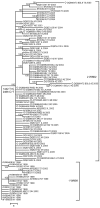Genetic variability of West Nile virus in US blood donors, 2002-2005
- PMID: 18325259
- PMCID: PMC2570840
- DOI: 10.3201/eid1403.070463
Genetic variability of West Nile virus in US blood donors, 2002-2005
Abstract
West Nile virus (WNV) was detected in the United States in 1999, has reoccurred every summer since, and has become endemic. Transfusion transmission was documented in 2002, and screening of blood donations for WNV began in 2003. We investigated genetic variation of WNV in human isolates obtained from specimens collected from 30 infected blood donors who tested positive for WNV RNA during 2002-2005. Complete genomic sequences of 8 isolates and structural gene sequences from 22 additional isolates were analyzed. We found some genetic diversity in isolates from different geographic regions and genetic divergence from reported sequences from epidemics in 1999-2001. Nucleotide divergence of structural genes showed a small increase from 2002 (0.18%) to 2005 (0.37%), suggesting absence of strong selective pressure and limited genetic evolution of WNV during that period. Nevertheless, WNV has continued to diverge from precursor isolates as geographic distribution of the virus has expanded.
Figures



Similar articles
-
Genetic Variability of West Nile Virus in U.S. Blood Donors from the 2012 Epidemic Season.PLoS Negl Trop Dis. 2016 May 16;10(5):e0004717. doi: 10.1371/journal.pntd.0004717. eCollection 2016 May. PLoS Negl Trop Dis. 2016. PMID: 27182734 Free PMC article.
-
Genetic analysis of West Nile virus isolates from US blood donors during 2002-2005.J Clin Virol. 2008 Nov;43(3):292-7. doi: 10.1016/j.jcv.2008.08.004. Epub 2008 Sep 24. J Clin Virol. 2008. PMID: 18818120
-
Co-circulation dynamics and persistence of newly introduced clades of 2012 outbreak associated West Nile Virus in Texas, 2012-2015.Infect Genet Evol. 2018 Dec;66:13-17. doi: 10.1016/j.meegid.2018.08.025. Epub 2018 Aug 25. Infect Genet Evol. 2018. PMID: 30153478
-
Keeping Blood Transfusion Safe From West Nile Virus: American Red Cross Experience, 2003 to 2012.Transfus Med Rev. 2015 Jul;29(3):153-61. doi: 10.1016/j.tmrv.2015.03.001. Epub 2015 Mar 22. Transfus Med Rev. 2015. PMID: 25841631 Review.
-
Molecular epidemiology and evolution of West Nile virus in North America.Int J Environ Res Public Health. 2013 Oct 16;10(10):5111-29. doi: 10.3390/ijerph10105111. Int J Environ Res Public Health. 2013. PMID: 24135819 Free PMC article. Review.
Cited by
-
Multiple pathways to the attenuation of West Nile virus in south-east Texas in 2003.Virology. 2010 Sep 15;405(1):8-14. doi: 10.1016/j.virol.2010.04.022. Epub 2010 Jun 30. Virology. 2010. PMID: 20580395 Free PMC article.
-
Spatiotemporal characterizations of dengue virus in mainland China: insights into the whole genome from 1978 to 2011.PLoS One. 2014 Feb 14;9(2):e87630. doi: 10.1371/journal.pone.0087630. eCollection 2014. PLoS One. 2014. PMID: 24551062 Free PMC article.
-
Anti-West Nile virus activity of in vitro expanded human primary natural killer cells.BMC Immunol. 2010 Jan 20;11:3. doi: 10.1186/1471-2172-11-3. BMC Immunol. 2010. PMID: 20089143 Free PMC article.
-
Evolutionary dynamics of West Nile virus in the United States, 1999-2011: phylogeny, selection pressure and evolutionary time-scale analysis.PLoS Negl Trop Dis. 2013 May 30;7(5):e2245. doi: 10.1371/journal.pntd.0002245. Print 2013. PLoS Negl Trop Dis. 2013. PMID: 23738027 Free PMC article.
-
Complete genome analysis and virulence characteristics of the Louisiana West Nile virus strain LSU-AR01.Virus Genes. 2009 Apr;38(2):204-14. doi: 10.1007/s11262-008-0321-2. Epub 2009 Jan 8. Virus Genes. 2009. PMID: 19130199
References
-
- Petersen LR, Marfin AA. West Nile virus: a primer for the clinician. Ann Intern Med. 2002;137:173–9. - PubMed
Publication types
MeSH terms
Substances
Grants and funding
LinkOut - more resources
Full Text Sources
Medical
